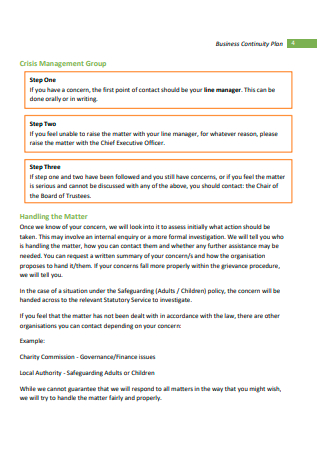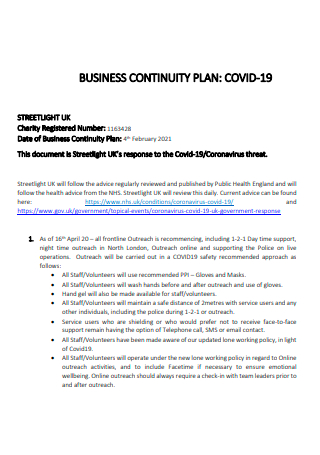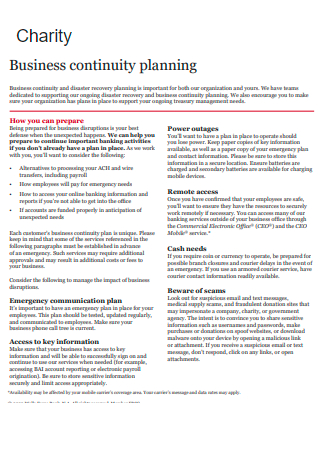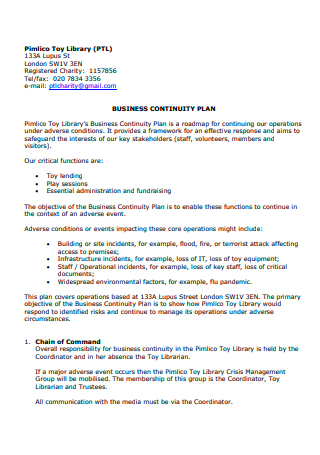3+ Sample Charity Business Continuity Plan
FREE Charity Business Continuity Plan s to Download
3+ Sample Charity Business Continuity Plan
What IS a Charity Business Continuity Plan?
Advantages of a Business Continuity Plan
Creating the Charity Business Continuity Plan
FAQs
What are some of the different types of charities?
What are some of the different types of donors?
What is the significance of a business continuity plan?
What IS a Charity Business Continuity Plan?
A Charity Business Continuity Plan is a documented process that helps your charity prepare for any adverse event, potential threats or risks, incident, or crisis that could halt or disrupt the whole business operation. It contains a step-by-step process that identifies adverse events or potential threats and then provides action items on how best to avert the threats or minimize the effect of potential damages. As the word continuity suggests, it’s a continuity plan of the charity organization’s operation, that despite being halted, will quickly get back on its feet and resume its operation. Examples of adverse events, threats, or risks to a charity organization are number one, the recent pandemic. Then there are also the extreme weather conditions. Then we have terrorism, supply order chain issues, digital technology issues, and so on. Source of funding is the main thing that is greatly affected in a charity organization. In the case of our current pandemic, sources of funds coming from support groups and third parties are now averted to address more pressing issues in regards to health and welfare. Who, then, can continue to support charities? Where will charities look for funding? And if there is an existing supply of funds, how will a charity organization continue to operate, considering a lot of restrictions have been put in place, with number one of them all being the social distancing? These are the questions that an effective charity business continuity plan should be able to answer.
Advantages of a Business Continuity Plan
Be prepared and stay prepared. That could be a good theme for a business continuity plan. Business continuity plans are often referred to as disaster recovery plans, mainly because the objective of a business continuity plan is to resume the business’s operation as quickly as it can after a crisis. A crisis or an adverse event is oftentimes unpredictable or referred to in most cases, a force majeure. In reality, no one could predict when a crisis would happen, and once it happens, what is the extent of its damages or its impact upon a business’s operation. The good news is you have a business continuity plan, which is the sole purpose why business continuity plans are created. Read on to find out what are the main advantages of having a business continuity plan.
Creating the Charity Business Continuity Plan
Knowing what are the advantages of having a business continuity plan is half the battle. Knowing how to effectively create one wins the war. Charity organizations are the most exposed and vulnerable to risks, threats, or disasters compared to any other institutions since charity organizations are usually not self-sustaining, and they rely mostly on third parties to fund their programs and activities. Or, they rely on their fundraising activities to augment their funds. But, especially during this pandemic, all sorts of activities are put on a halt to implement social distancing, thereby affecting another source of income for the charity organizations. So, how can a charity organization resolve this to continue operating? That’s where a charity business continuity plan comes in. Although there are no strict rules on how to format a business continuity plan, still, what’s important is that the essential elements are included when making one.
-
1. Executive Summary
The executive summary in a charity business continuity plan provides an overview of what the content of the plan looks like. It includes the goals and objectives for having a continuity plan, as well as the need for making one. It also presents the current environment scenario that answers the need for creating the plan. It depicts what are the risks, threats, disasters, or adverse events that could potentially arise, especially from where the charity is located. An executive summary often contains a mission and vision statement. A mission statement explains the purpose of the business continuity plan. It also reflects the charity organization’s culture and values. A vision statement describes what the charity organization hopes to achieve through its business continuity plan, usually in a specified period. The vision statement serves as a call to action, a motivation, or an inspiration especially for the employees that the organization has backup plans to keep the charity operation running smoothly despite any kinds of events.
-
2. Creating a Business Continuity Management Team
A business continuity management team is a group of people dedicated to dealing and handling disasters and crises and the impact on the business. They are the ones that execute and implement the action steps for business recovery and restoration. They are considered the frontliners, the first people to execute continuity actions, to ensure that the business continues despite any kinds of crises. The business continuity management team should, at a minimum, consist of a manager, an assistant manager, and an administrative assistant. For a charity organization, depending on how big the organization is, the management team can be taken from the current rank and file roles. The organization should allow a separate organizational chart specifically for the business continuity plan and should include details of each team member such as their names, roles and positions, address, contact number, and what is their role or designation in the business continuity management team. Each role within the team should be identified, what they should do and how they will be enacting their roles. For instance, one team member is put in charge of communication, wherein that member is the focal point person of all communication taking place during a crisis. That person is in charge of keeping a directory and contacting the appropriate authorities in case of disaster or crisis, such as fire, earthquakes, accidents or injuries, et cetera. Another team member is assigned to client or customer relations, ensuring the clients that the organization is still in operation. Another team member should be assigned in technology, being in charge of technologies and software for concerns arising from work from home setup.
-
3. Business Impact Analysis
Once you have your team set up, it’s time to analyze what are the possible impacts or effects a disaster or a crisis will have on the organization. Similar to market analysis, a business impact analysis studies first the current market’s condition and its target market. In a charity organization, the market considered impacted are the recipients of the charity’s services. Also, another area that’s potentially affected is the source of funds for the organization, as well as the implementation of its fundraising activities. To do an analysis, first identify what are the threats or crises a charity organization could face, and what are the impacts that could likely happen. Aside from the obvious impact of cut-off from funding, another impact could be the unavailability of working space and technology. Another could be the inability to reach out or access to charity recipients, either to communication lines cut-off, roadblocks, extreme weather, et cetera.
-
4. Recovery Strategies
Fundraising activities and funds coming from third parties are the first things brought to halt in a charity organization when a disaster strikes. To counteract the disruption and to continue generating funds, one of the best strategies to prepare for this type of scenario is to create an online presence through a website using SEO marketing strategy, blogs, and vlogs, or be active in social media or social networking platforms to establish the organization’s legitimacy. Aside from registering for the IRS, of course. Avail of funding or donations through crowdfunding platforms, such as GoFundMe, Fundly, et cetera. To anticipate the adverse impact on the organization’s facility, a work from home set-up should be planned. Maximizing online communication and meeting digital platforms such as Zoom, Google Meet, Skype to keep in constant communication with volunteers, donors, and other stakeholders. Another strategy is anticipating and mitigating risk before disaster strikes through proper training such as fire and earthquake drills, training to secure confidential files to prevent cyberattacks, et cetera.
FAQs
What are some of the different types of charities?
Charities come in different shapes and sizes, depending on the purpose and the service they fulfill. Some of the types of charities that we are familiar with are human services, which are your food banks, homeless shelters, social services, et cetera; animal charities; environmental charities; health charities; education charities; international NGO charities, and so on.
What are some of the different types of donors?
Donors are classified according to how big the organization they belong to, or according to the purpose why they donated. These types of donors are the individual donors, the major donors, the corporate donors, and the foundations. Individual donors are your average Joe’s, next-door neighbor, your friends, your families, and even those individuals donating from crowdfunding platforms. Major donors typically started as individual donors that have stayed on and are certified long-time donors of a charity. Major donors usually can give larger gifts or donations. Although there is no fixed amount as to how many major donors give, still, their donations tend to hugely impact the charity organization. Corporate donors are the third type of donors. Corporate donations are either CEO initiated, board of directors initiated, or initiated because of a marketing strategy intended to partner up with charitable organizations as a way to enhance the company’s or brand’s visibility in the market. Foundations, the fourth type of donor, are registered and function within tax laws. They provide so-called “grants” to fund one or two charitable causes.
What is the significance of a business continuity plan?
Business continuity plans are proactive by nature. Having a good continuity plan means that the business can cope with the aftermath of a disaster strike, can be able to smoothly continue operation and retain customer relations, and preserve and earn a good business reputation as a business that customers, and even employees, could trust.
No one could have predicted when an earthquake would strike. No one could predict when a fire disaster would happen. Most especially, no one could have possibly predicted the COVID-19 pandemic that largely affected and negatively impacted the whole world. These occurrences do not do well at all for any kind of business. That’s why at the onset of a business startup, along with formulating a business plan, marketing plan, and even a financial plan, a business continuity plan should be created alongside as well. This is what all businesses need to have to be prepared, to be proactive, especially in the charity sector.
Need help in making that charity business continuity plan? Download our charity business continuity plan templates now, and start taking proactive steps to protect your charity organization!




